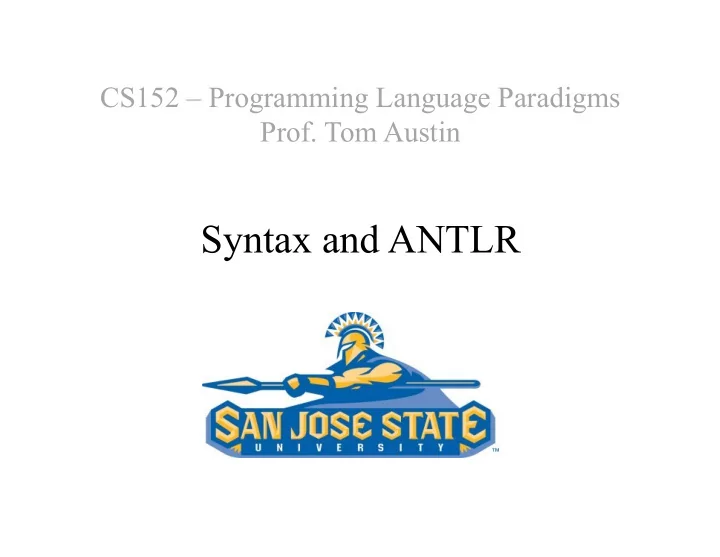

CS152 – Programming Language Paradigms Prof. Tom Austin Syntax and ANTLR
Syntax vs. Semantics • Semantics: – What does a program mean? – Defined by an interpreter or compiler? • Syntax: – How is a program structured? – Defined by a lexer and parser
Review: Overview of Compilation Lexer/ source tokens Parser code Tokenizer Abstract Compiler Interpreter Syntax Tree (AST) Machine code Commands
Tokenization Lexer/ source tokens Parser code Tokenizer Abstract Compiler Interpreter Syntax Tree (AST) Machine code Commands
Tokenization • Process of converting characters to the words of the language. • Generally handled through regular expressions. • A variety of lexers exist: – Lex/Flex are old and well-established – ANTLR & JavaCC both handle lexing and parsing • Sample lexing rule for integers (in Antlr) INT : [0-9]+ ;
Categories of Tokens • Reserved words or keywords – e.g. if , while • Literals or constants – e.g. 123 , "hello" • Special symbols – e.g. " ; ", " <= ", " + " • Identifiers – e.g. balance , tyrionLannister
Lexing in ANTLR (v. 4) (in class)
Parsing Lexer/ source tokens Parser code Tokenizer Abstract Compiler Interpreter Syntax Tree (AST) Machine code Commands
Parsing • Parsers take the tokens of the language and combines them into abstract syntax trees (ASTs). • The rules for parsers are defined by context free grammars (CFGs). • Parsers can be divided into – bottom-up/shift-reduce parsers – top-down parsers
Context Free Grammars • Grammars specify a language • Backus-Naur form is a common format Expr -> Number | Number + Expr • Terminals cannot be broken down further. • Non-terminals can be broken down into further phrases.
Sample grammar expr -> expr + expr | expr – expr | ( expr ) | number number -> number digit | digit digit -> 0 | 1 | 2 | 3 | … | 9
Bottom-up Parsers • Also known as shift-reduce parsers – shift tokens onto a stack, then reduce to a non- terminal. • LR: left-to-right, rightmost derivation • The most common type of bottom-up parsers are Look-Ahead LR parsers (LALR) – YACC/Bison are examples • Generally considered to be more powerful, though they seem to be fading from popularity.
Top-down parsers • Non-terminals are expanded to match incoming tokens. • LL: left-to-right, leftmost derivation • LL(k) parsers can look ahead k elements to decide which rule to use. – example LL(k) parser: JavaCC • LL(1) parsers (known as recursive descent ) parsers are of special interest: – Easy to write/fast execution time – Some languages are designed to be LL(1)
Antlr • Antlr v. 1-3 were LL(*) – Similar to LL(k), but can look ahead as far as needed. • Antlr v. 4 is Adaptive LL(*), or ALL(*) – Allows us to write left-recursive grammars that were not previously possible with LL parsers. http://www.antlr.org/papers/allstar-techreport.pdf – Sample left-recursive grammar: expr -> expr + expr | num
Parsing with ANTLR (in-class)
Lab: Getting to know Antlr Write a calculator using Antlr. Details in Canvas, starter code on course website.
Recommend
More recommend